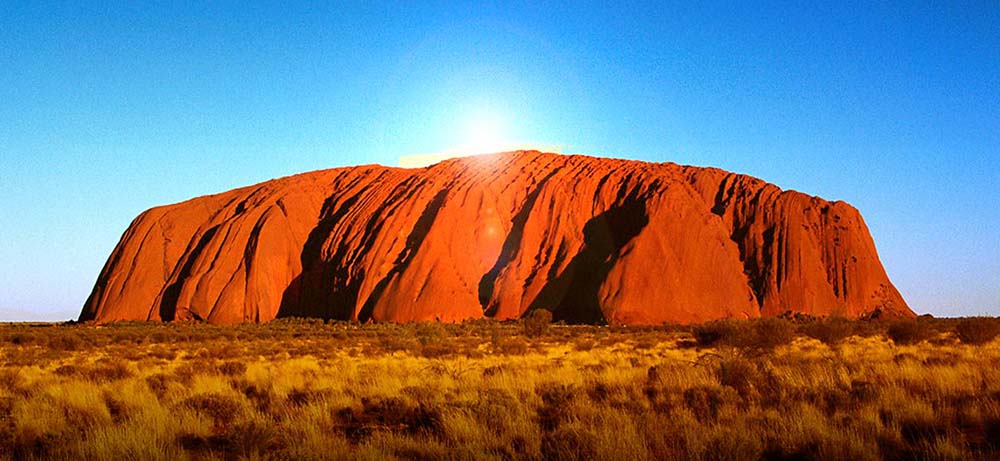
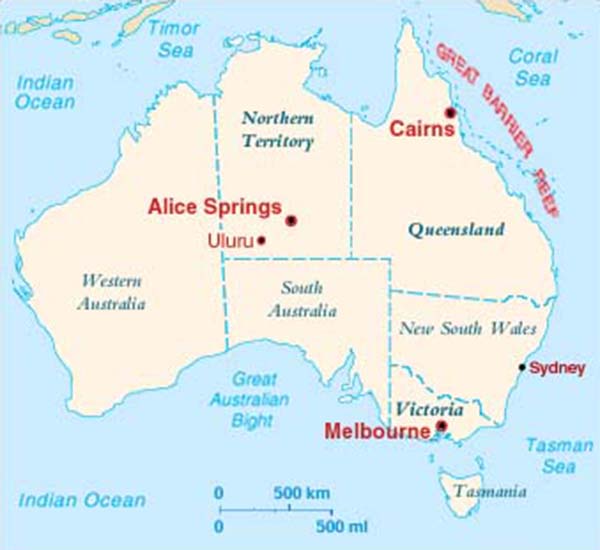


Ayers Rock is also known by its Aboriginal name 'Uluru'. It is a sacred part of Aboriginal creation mythology, or dreamtime - reality being a dream. Uluru is considered one of the great wonders of the world and one of Australia's most recognizable natural icons. Uluru is a large magnetic mound large not unlike Silbury Hill in England. It is located on a major planetary grid point much like the Great Pyramid in Egypt.
Ayers Rock is a large sandstone rock formation in central Australia, in the Northern Territory. It is located in Uluru-Kata Tjuta National Park, 350 km southwest of Alice Springs at 25 degrees 20' 41" S 131 degrees 01' 57" E. It is the second-largest monolith in the world (after Mount Augustus, also in Australia), more than 318 m (986 ft) high and 8 km (5 miles) around. It also extends 2.5 km (1.5 miles) into the ground. It was described by explorer Ernest Giles in 1872 as "the remarkable pebble".'
Uluru is an inselberg, literally "island mountain", an isolated remnant left after the slow erosion of an original mountain range. Uluru is also often referred to as a monolith, although this is a somewhat ambiguous term because of its multiple meanings, and thus a word generally avoided by geologists. The remarkable feature of Uluru is its homogeneity and lack of jointing and parting at bedding surfaces, leading to the lack of development of scree slopes and soil. These characteristics led to its survival, while the surrounding rocks were eroded. For the purpose of mapping and describing the geological history of the area, geologists refer to the rock strata making up Uluru as the Mutitjulu Arkose, and it is one of many sedimentary formations filling the Amadeus Basin.
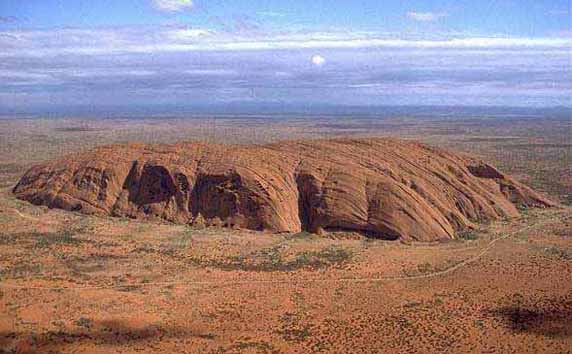
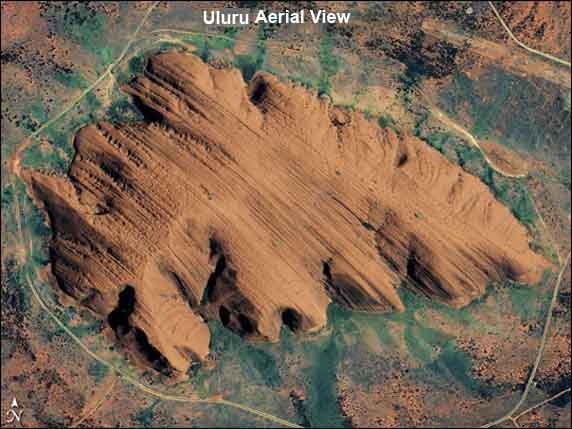
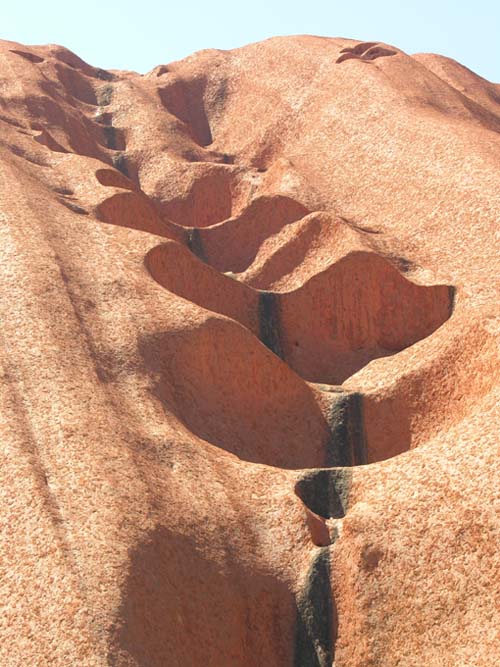
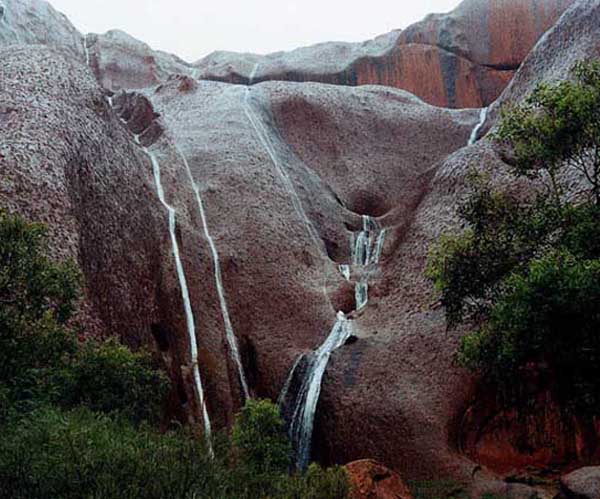
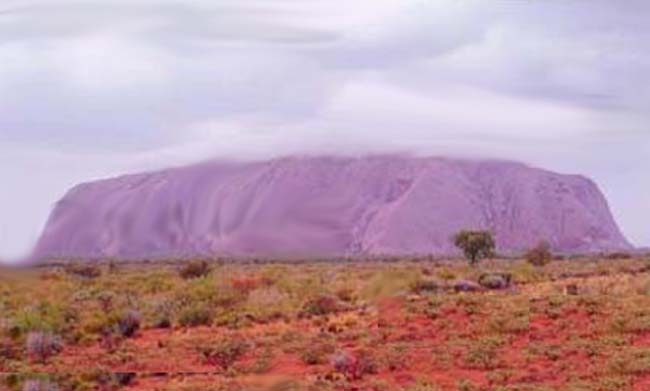
Waterfalls on the rocks causing the color change.
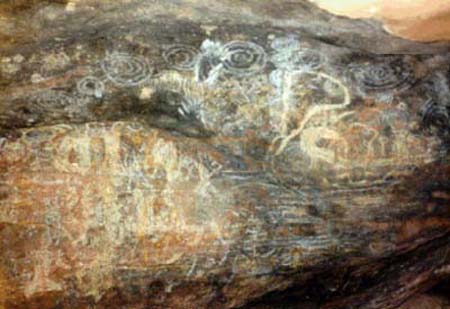
depicting Dreamtime myths dating back thousands of years.
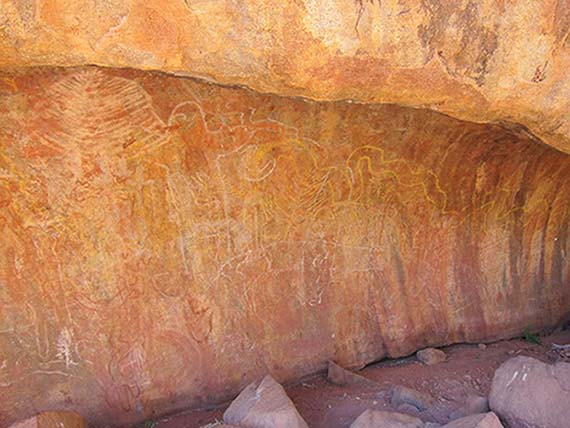
The Mutitjulu Arkose is believed to be of about the same age as the conglomerate at Kata Tjuta, and to have a similar origin despite the rock type being different, but it is younger than the rocks exposed to the east at Mount Conner, and unrelated to them. The strata at Uluru are nearly vertical, dipping to the south west at 85 degrees, and have an exposed thickness of at least 2,400 m (7,900 ft).
The strata dip below the surrounding plain and no doubt extend well beyond Uluru in the subsurface, but the extent is not known. The rock was originally sand, deposited as part of an extensive alluvial fan that extended out from the ancestors of the Musgrave, Mann and Petermann Ranges to the south and west, but separate from a nearby fan that deposited the sand, pebbles and cobbles that now make up Kata Tjuta.
The similar mineral composition of the Mutitjulu Arkose and the granite ranges to the south is now explained. The ancestors of the ranges to the south were once much larger than the eroded remnants we see today. They were thrust up during a mountain building episode referred to as the Petermann Orogeny that took place in late Neoproterozoic to early Cambrian times (550-530 Ma), and thus the Mutitjulu Arkose is believed to have been deposited at about the same time.
The arkose sandstone which makes up the formation is composed of grains that show little sorting based on grain size, exhibit very little rounding and the feldspars in the rock are relatively fresh in appearance. This lack of sorting and grain rounding is typical of arkosic sandstones and is indicative of relatively rapid erosion from the granites of the growing mountains to the south. The layers of sand were nearly horizontal when deposited, but were later tilted to their near vertical position during a later episode of mountain building, possibly the Alice Springs Orogeny of Palaeozoic age (400-300 Ma).
Despite current estimates of the age of the geological formations that comprise Uluru, however, the arkose sandstone which makes up the formation is composed of grains that are many different sizes and are jagged, and the feldspars in the rock are fresh and shiny. Flood geologists argue that this indicates a comparatively fast deposit, on the order of only a few years or less. They state that if the arkose grains had been transported more slowly they would be more rounded and evenly sorted, and the feldspars would have turned to clay in the intervening years.
Archaeological findings to the east and west indicate that humans settled in the area more than 10,000 years ago. Europeans arrived in the Australian Western Desert in the 1870s. Uluru and Kata Tjuta were first mapped by Europeans in 1872 during the expeditionary period made possible by the construction of the Australian Overland Telegraph Line. In separate expeditions, Ernest Giles and William Gosse were the first European explorers to this area.
While exploring the area in 1872, Giles sighted Kata Tjuta from a location near Kings Canyon and called it Mount Olga, while the following year Gosse observed Uluru and named it Ayers Rock. Further explorations followed with the aim of establishing the possibilities of the area for pastoralism. In the late 1800s, pastoralists attempted to establish themselves in areas adjoining the South western/Petermann Reserve and interaction between Anangu and white people became more frequent and more violent. Due to the effects of grazing and drought, bush food stores became depleted. Competition for these resources created conflict between the two groups, resulting in more frequent police patrols. Later, during the depression in the 1930s, Anangu became involved in dingo scalping with 'doggers' who introduced Anangu to European foods and ways.
Between 1918 and 1921, large adjoining areas of South Australia, Western Australia and Northern Territory were declared as Aboriginal reserves, sanctuaries for nomadic people who had virtually no contact with European settlers. In 1920, part of Uluru - Kata Tjuta National Park was declared an Aboriginal Reserve (commonly known as the South-Western or Petermann Reserve) by the Australian government under the Aboriginals Ordinance.
The first tourists arrived in the Uluru area in 1936. Beginning in the 1940s, permanent European settlement of the area for reasons of the Aboriginal welfare policy and to help promote tourism of Uluru. This increased tourism prompted the formation of the first vehicular tracks in 1948 and tour bus services began early in the following decade.
In 1958, the area that would become the Uluru - Kata Tjuta National Park was excised from the Petermann Reserve; it was placed under the management of the Northern Territory Reserves Board and named the Ayers Rock - Mount Olga National Park. The first ranger was Bill Harney, a well-recognised central Australian figure. By 1959, the first motel leases had been granted and Eddie Connellan had constructed an airstrip close to the northern side of Uluru.
On 26 October 1985, the Australian government returned ownership of Uluru to the local Pitjantjatjara Aborigines, with one of the conditions being that the Anangu would lease it back to the National Parks and Wildlife agency for 99 years and that it would be jointly managed. The Aboriginal community of Mutitjulu, population of approximately 300, is located near the western end of Uluru. From Uluru it is 17 km (11 mi) by road to the tourist town of Yulara, population 3,000, which is situated just outside of the national park.
Kata Tjuta National Park is owned and run by the local Aboriginals. The Australian government handed ownership of the land back to the Aboriginals some years ago.
Ayers Rock was named for the Premier of South Australia, Sir Henry Ayers. It extends down over 3 and a half miles beneath the surface. Approximately 500 million years ago it was part of the ocean floor at the center of Australia. Some report that there is a light source emanating at various times of the year. Most likely this can be explained scientifically.
The Aborigines believe that there it is hollow below ground, and that there is an energy source that they call 'Tjukurpa' the dream time. The term Tjukurpa is also used to refer to the record of all activities of a particular ancestral being from the very beginning of his or her travels to their end. Anangu know that the area around
Ayers Rock (Mount Uluru) is inhabited by dozens of ancestral 'beings' whose activities are recorded at many other sites. At each site, the events that took place can be recounted, whether those events were of significance or whether the ancestral being just rested at a certain place before going on.
Usually, there is a physical feature of some form at each ancestral site which represents both the activities of the ancestral being at the time of its formation and the living presence of Tjukurpa within that physical feature today. For the Australian Aboriginal people, that physical feature, whatever its form or appearance, animate or inanimate, is the Tjukurpa. It may be a rock, a sand hill, a grove of trees, a cave. For all of these, the creative essence remains forever within the physical form or appearance.
Around Mount Uluru there are many examples of ancestral sites. The Anangu explanations of these sites and of the formation of Mount Uluru itself derive from the Tjukurpa. Most of these explanations are in the realm of secret information and are not disclosed to Piranypa, the non-Aborigines.
'The Dreaming' is not a creation myth, per se, but a myth of formation. The world existed, but was featureless. Giant semi-human beings, resembling plants or animals, rose up from the plains where they had been slumbering for countless ages.
These ancient heroes roamed the land aimlessly. As they wandered around, they carried out the tasks that the present Aborigines do today including camping, making fires, digging for water, fighting each other, and performing ceremonies. When the heroes became tired of doing these things, Dreamtime came to an end.
Wherever the creators had been active, some form of natural feature now marks the place. The creators made everything with which the aborigines are in daily contact and from which they gain their living. The heroes also established laws that govern all aspects, both secular and sacred, of the tribes.
Dreamtime was in the past, but it is the Aborigines present religion and culture. The saying, 'As it was done in the Dreamtime, so it must be done today,' dominates all aspects of aboriginal behavior. Because of their beliefs in 'the dreaming,' ceremonies and rituals are held, stories are told, pictures are drawn, and daily life is defined.
In order to understand the religion of the Aborigines, one must have a basic understanding of the organization of the tribes. All men and women belong to small groups, called clans. Each clan posses a distinct body of spiritual properties, or sacred sites. A clan may have several sacred sites that they claim, and the area surrounded by the connection of these sites forms the clan's estate. Clans are linked by common religious traditions, intermarriage, shared dialects, and overlapping foraging rights.
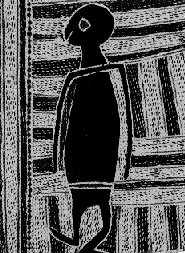
Clans people of the crow believe they are descended from
the Dreamtime's crow spirit who became a man.
Each clan has a totem. 'Totemism is a view of nature and life, of the universe and man, which colors and influences the Aborigines' social groupings and mythologies, inspires their rituals and links them to the past. It unites them with nature's activities and species in a bond of mutual life-giving, and imparts confidence amidst the vicissitudes of life'. The totem provides a tangible expression of a man's relationship to his deities. Everything in the Aboriginal world contains an essence or spirit that had its beginnings in the Dreamtime. Each person descended from one of these spirits and possessed some of its life force. The spirit it descended from is the person's totem. Images of totems make-up a large part of Aboriginal art. They were painted on cave walls, which we title rock art, drawn on the interiors of their huts, drawn on their bodies, and carved in wood. Totemic spirits are celebrated in ceremonies and rituals, and played a prominent part in Aboriginal myth.
According to the Anangu traditional landowners of Uluru:
There are a number of unauthenticated accounts of the Aboriginal ancestral stories for the origins of Uluru and its many cracks and fissures. One such account, taken from Robert Layton's (1989) ULURU: An Aboriginal history of Ayers Rock, reads as follows:
Two other accounts are given in Norbert Brockman's (1997) Encyclopedia of Sacred Places. The first tells of serpent beings who waged many wars around Uluru, scarring the rock. The second tells of two tribes of ancestral spirits who were invited to a feast, but were distracted by the beautiful Sleepy Lizard Women and did not show up. In response, the angry hosts sang evil into a mud sculpture that came to life as the dingo. There followed a great battle, which ended in the deaths of the leaders of both tribes. The earth itself rose up in grief at the bloodshed, becoming Uluru.
The Commwealth Department of Environment's webpage advises:
"Kuniya, the woma python, lived in the rocks at Uluru where she fought the Liru, the poisonous snake."
The epic, 550-million-year story of Uluru and the spectacular forces that led to its formation PhysOrg - December 30, 2021
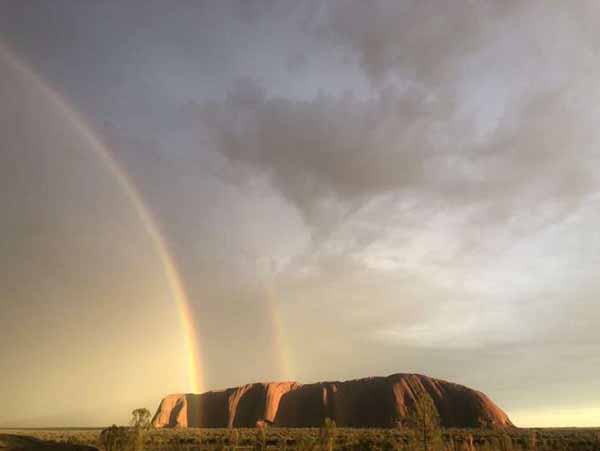
Part of the magic of Uluru is the way it tricks your senses. Deep orange by day, at sunrise and sunset it appears to change color, becoming a more vibrant shade of red, and then almost purple. Uluru is a time capsule. Within its sand grains there is an epic 550-million-year saga of continents colliding, mountains rising and falling, and the remarkable strength of our most iconic mountain.
Uluru ban: What do locals think of the final rush to climb Uluru? BBC - October 24, 2019
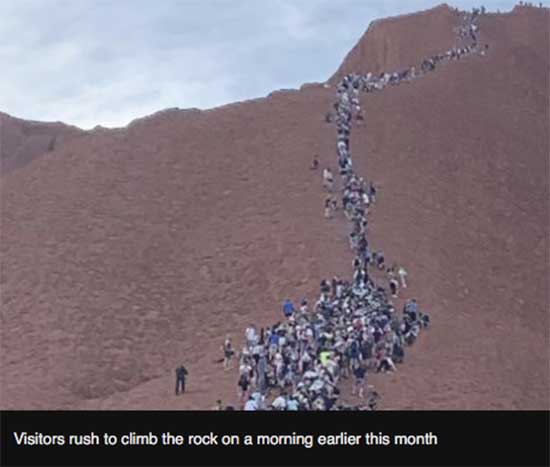
For decades, hundreds of thousands of visitors to Australia's desert centre have trekked up Uluru, the ancient red monolith formerly known as Ayers Rock. Starting Saturday, the climb will be banned. Uluru is a sacred site for the local indigenous custodians, the Anangu people, who have long asked tourists not to go up.